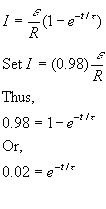| B-Plot Explanation. Helps you understand the First Lab you did. Click here. |
| 8.
When the current decreases, and the derivative of the current is negative, the difference in the potential is positive (again, because of the minus sign in the formula.) That is, the voltage at terminal a is less than the voltage at terminal b. This is like an induced battery acting with polarity in the same direction as the current to oppose the decrease in I.
Keep these points in mind when you express the magnitude of the induced voltage: |
24. See Eqn. 32.7: Set t = 0.003 sec. Take the natural log of both sides and find the inductance L. |
| 32. (a) Use eqn. 32.14, to find the magnetic energy density.
Also, review fig. 30.18, Ch. 30. The magnetic field vector is uniform inside the
solenoid, as shown. Thus, the magnetic field density is also constant there. (b) The magnetic energy equals the result in part (a) multiplied by the inner volume of the solenoid. To get the answer, find the volume of a cylinder of radius r and height h. Hint: This is equal to the area of a circle multiplied by a height. |
| 53. Study figs. 32.14 and
32.15. At t = 0, the charge on the capacitor plate is a maximum. In general,  In this case, because the charge is a maximum at t = 0, the phase constant is zero. Thus, (a) Use eqn. 32.22. Remember that: (b) Substitute t = 0.001 sec into the above expression for the charge. (c) Differentiate the expression for the charge. You notice that you get a negative result when you substitute t = 0.001 sec. This is the convention for a capacitor that is discharging. The charge on the positive plate is decreasing. The current flows out of the positive plate and is taken to be negative. |

